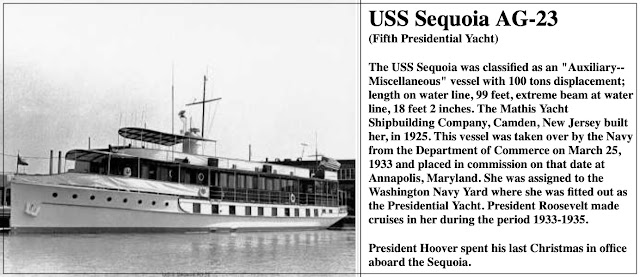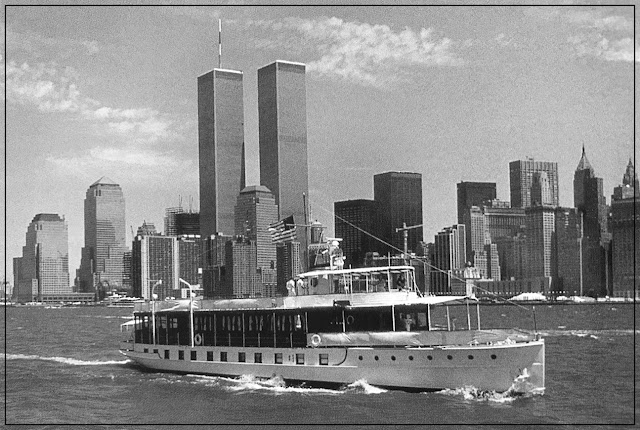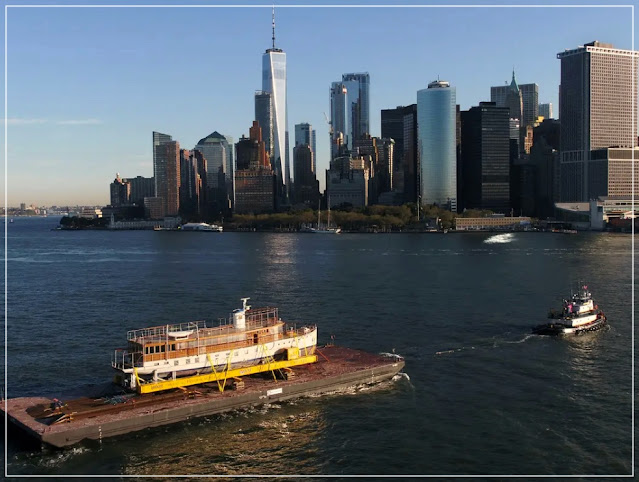 This is quite a lengthy post, per my usual ones which focus on historical places and things that attract me to learn more. And, since it's always nice to share knowledge, now you know too.
This is quite a lengthy post, per my usual ones which focus on historical places and things that attract me to learn more. And, since it's always nice to share knowledge, now you know too.This post is a continuation of an earlier one about two yachts we saw in Belfast, ME, shipyards during a July visit. That earlier post focused on one of the two yachts in the photo on the right ➨.
This photo was displayed in the previous post along with a question about which one was in better shape.
And, if you read the previous post (or not) the answer is the top yacht, Cangarda, one of three remaining steam yachts worldwide.
Both of these vessels are historical, but for different reasons. The bottom one has the most history as it pertains to the U.S. as you will read and see in this post. And, I am not a boat person, when we found out it was in a location we were staying, I had to learn more.
The photos above are of the second yacht as it is today. It's clearly visible, that it's in very rough condition, which doesn't bode well for its former prominence. But then, Cangarda was in the same predicament before complete a restoration which took many years and many $$$. And, this one is in the same situation—time and money can work wonders.
If you haven't figured out the significance of this yacht; its nameplate gives it away, the USS Sequoia. In much better days, it was the floating White House from 1931 to 1977. Up to 10 U.S. Presidents have been on board, Herbert Hoover to Bill Clinton, (even after the yacht was sold by one of them). No, I didn't know there was a Presidential yacht, but then the yacht preceded the time before a presidential plane.
Here's a few ways it was used by presidents: Franklin D. Roosevelt had a wheelchair lift installed. Harry Truman made the decision to drop an atomic bomb on Hiroshima while onboard. Dwight Eisenhower allowed Queen Elizabeth II to use it during a visit. In 1963, John F. Kennedy celebrated what became his last birthday onboard. Lyndon Johnson watched films considered risqué if in the White House. The most time onboard was spent by Richard Nixon, who played the piano. Reportedly, it was where he decided to resign the presidency.
Sadly, the Sequoia is in such disrepair that it can no longer float on its own. The above photos show it as seen in July on boat stands at the French & Webb boatyard in Belfast, ME. This specialty boatyard has been contracted to bring back the seaworthiness and elegance of this famous vessel. From all that I have read, this will be a long process.
The USS Sequoia, is an impressive sight even in its current state. This 182,000 lb, 104-foot long wooden yacht was one of the largest personal yachts of its time.
Formally decommissioned in December 1935, by President Franklin D. Roosevelt, it continues to carry its “USS” designation and was designated a National Historic Landmark in 1987.
Formally decommissioned in December 1935, by President Franklin D. Roosevelt, it continues to carry its “USS” designation and was designated a National Historic Landmark in 1987.
Surprisingly, like many things, it has a connection to our home state of New Jersey where it was built in 1925 for a woman raised in NJ who shared the same September 9 birthdate as my late mother (different birth years).
 |
| Emily Roebling |
The yacht was designed and built for Emily Roebling Cadwalader. If that name seems familiar, it's because Ms. Roebling was the granddaughter of John Augustus Roebling, the civil engineer for the Brooklyn Bridge. Raised in Trenton, NJ, she was one of the first women to drive her own car there. She married Richard M. Cadwalader, a prominent Philadelphia banker, who shared her interest in large yachts, which luckily they could well afford too.
The Sequoia II, as it was originally named, preceded the 85-foot Sequoia I, which the couple owned before and which was also designed by Trumpy. These handmade wooden vessels, built for the rich and famous, enabled a very comfortable lifestyle. Sequoia's hull was constructed of yellow-leaf pine, the deckhouse was made of mahogany and teak.
 |
| Online source: Vintage ad for Mathis Company lists Sequoia I and II; notice that Emily Roebling's name was not included, only her husband |
Built in 1925 at a cost of about $200,000—equal to $3,223,145 now, it was the second of four successively larger yachts built between 1924 and 1931 for the couple. Years ago, luxury boats were the preferred transport for wealthy easterners who wanted to escape winter weather and escape to warmer states, like Florida. Instead of the term yacht that's now used, these luxury boats were called house boats as shown in the vintage ad above for the Mathis Company.
 |
| Online source: Sequoia II (as it was known then) in 1926 |
In 1931, the U.S. Department of Commerce bought Sequoia II from Dunning for about $40,000 justifying the cost as it was used as a decoy for rum-runners during Prohibition. Yes, I wondered about that use myself. It would patrol the Chesapeake and Delaware Bays as a decoy vessel to attract would-be bootleggers who hoped to sell illegal liquor and would come alongside what they assumed was a wealthy owner's yacht, only to be arrested.
 |
| Presidential Herbert Hoover |
In March 1933, the yacht, now known as Sequoia, became the official presidential yacht and was transferred from the Department of Commerce to the Naval Department, gaining its USS status. Hoover used it as the presidential yacht for the last two years of his presidency, including 1931-1933 voyages for business and pleasure cruises.
Here's a fun twist, according to some sources, Sequoia was decommissioned as an official Navy vessel during WW II—alcoholic beverages were prohibited onboard commissioned naval vessels, so that world leaders, like Winston Churchill, could drink liquor onboard. The problem is that Churchill was never documented as being aboard the yacht.
 |
| Online source: U.S. Navy classification |
From 1936 to 1939, the USS Sequoia was used as the yacht of the Secretary of the Navy and from 1939 to 1977, used by the Navy, the President and executive branch officials.
 |
| Online sources: U.S. Presidents onboard USS Sequoia, FDR to Nixon |
Sequoia was sold by a President
All good things come to an end. In 1977, President Jimmy Carter, decided it wasn't right to spend taxpayers dollars on such a luxury item and ordered Sequoia sold at auction to reduce Federal government spending. Sequoia was costing U.S. taxpayers an estimated $800,000 annually at the time. Later, Carter was said to have regretted his decision as a mistake.
 |
| Online source: Presidential bedroom onboard USS Sequoia (in better days) |
A RI contractor, Thomas Malloy, purchased Sequoia from the government at auction in 1977 for the highest bid of $286,000, then spent $50,000 to turn it into a floating museum. It was anchored in RI at India Point Park. In July 1977, Malloy pulled anchor after only 500 people had visited at $2 each. In a New York Times article, he was quoted as saying that intense summer heat had deterred tourists and he hoped to find cooler air and better business in Newport, R.I.
Those plans didn't go well. Three months later, Malloy resold the yacht to a partnership for $355,00. It was maintained in Myrtle Beach, SC, then in 1980 again resold for $750,000 to The Ocean Learning Institute of Palm Beach, FL, which used it to entertain potential donors.
 |
| Online source: USS Sequoia on Hudson River, in NYC |
In the intervening years there were several other owners, including a potential Japanese buyer who wanted to buy and move it yacht to Tokyo.
Years later, it was involved in a lengthy legal battle after it had been hauled to a boatyard in Virginia. According to online accounts, the vessel had been damaged when it was hauled out of the water on a marine railway in 2014. The yacht was neglected and in danger of sinking.
The dispute was resolved after years of lengthy and complicated legal wrangling. Its current owner is the Equator Capital Group, a portfolio investment firm in Washington, D.C, which bought Sequoia in 2016 for $7.8 million.
 |
| Online source: USS Sequoia on barge in Hudson River, in NYC |
USS Sequoia arrived in New England in October 2019. A just over 2-minute video showing some of this amazing voyage and arrival in Belfast, ME, can also be viewed online here
Both videos provide the best overall views of this incredible-looking wooden yacht, especially the top-down images. USS Sequoia was not wrapped until after its arrival in ME.
That's Where It Remains
Since 2019, the 104-year old yacht has remained outdoors at the French and Webb boat yard under wraps. Like with most things, the pandemic delayed the start of restoration. While it seems like no work has been done. It's all been done behind the scenes.
According to several articles, skilled workers used laser technology to create a three-dimensional model; original design plans couldn't be found. They have also sourced rare wood and materials, including longleaf pine, from the Southeast and white oak from Denmark. No restoration costs have been disclosed.
Strict guidelines must be followed and restoration must be of museum-level archival quality. That's because the yacht is on the National Register of Historic Places.
Sequoia will remain in Belfast for the foreseeable future. Physical restoration is slated to start in the spring of 2023 and expected to take 3-4 years. Plans call for a protective housing to be built that would protect the yacht from the elements. Reportedly, it will have a walkway for the public to view the restoration process. From what we saw, there wasn't a rush on these plans.
After its restoration, the USS Sequoia is expected to return to Washington where it will be used as a venue to support ocean conservation.
We're planning a return to Belfast, ME, within a couple of years to see how the process is going. Of course, any visit will be included in a future post, if the visual work has started by then.
BIG THANKS to everyone for comments on my recent post with family members. As many noted, it's all good now to share special times after a stretch of not doing so.







16 comments:
I had no idea there was ever a presidential yacht. A very interesting history. I hope you get to see some progress when you visit.
I have never heard of the boats or the fact the presidents had a floating white house. wow..
'Sequoia' sounds like a lovely, melodious name!
Hopefully, after years of being sold and resold, the vessel gets to be successfully restored!
It sounds like a long process, but we'll worth doing.
They are both beautiful.
For the Sequoia to end its days as a vehicle for ocean conservation is very noble - and I hope successful. Nothing else seems to have worked so far.
All so interesting... I hope that the restoration does take place. Seems as if many notable people have had a history with the boat. Fascinating.
A very interesting history. I hope it does end up being restored.
Great to read through (over breakfast) and learn about the Sequoia's history. There's a typo on the date of her anniversary...it was 1986 not 1886...just under the wonderful photo of her sailing past the twin towers. Thanks for such a thorough history.
Interesting history. Nice to see JFK and Jackie on board. Yes, Carter was foolish to have the ship auctioned off.
I picked up my cup of tea and sat and enjoyed a very good read, thank you.
All the best Jan
You did a great job of research here; pictures and all. One correction at the beginning - if Carter was the one to sell the yacht then Clinton never would have used it. Clinton mentioned as last President to use it in this sentence "it was the floating White House for a number of U.S. presidents from 1931 to 1977, Herbert Hoover to Bill Clinton."
Great talking to you the other day and catching up on news.
Beatrice, We just returned from a 10 day road trip...with more blogging material than I really need! So now I'm catching up starting with your post about the former Presidential yacht. Great bit of research on your part. I was aware of the Sequoia II's situation but I'm happy that progress is slowly being made. It would be a travesty to lose this bit of history. Take Care, Big Daddy Dave
Thanks Marcia for the comment and while it is true that Sequoia was sold at auction by President Jimmy Carter before the presidency of Bill Clinton, he was later inboard when President.
That’s because when the Presidential Yacht Group LLC owned Sequoia, the yacht was made available in Washington, D.C. for private charters. Then President Clinton attended one such event aboard Sequoia in October 2000—making him the 10th person who served as U.S. president to walk upon Sequoia's decks.
I appreciated that you took the time to note a possible discrepancy.
That yacht definitely deserves to be restored. What a rich history. Then it needs to go into a museum. I can see why Roosevelt and Kennedy enjoyed it as they were boating guys. Great photos too. This was such an interesting post, as I am a boat person. Have a great trip visiting family. Hugs-Erika
How magnificent! Like you, I had no idea we once had a presidential yacht, although it does make a lot of sense. I'll bet it would have stories to tell. The photos are terrific. I am a big proponent of restoration of such things, as much as historic homes or buildings. This is clearly a huge part of history. Wonderful research and reporting, Dorothy. I really enjoyed this post!
Post a Comment